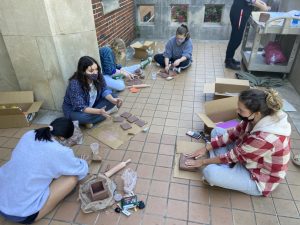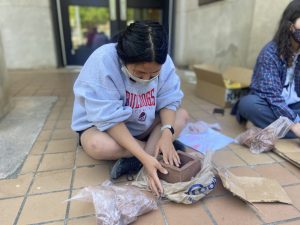Clarke Central High School fine arts department teacher Heather Garland stands at the side of the CCHS Ceremonial Entrance, where the Ceramics Club is often held, on April 22. Garland started the club as an introduction to Ceramics I, a new course being offered for the 2021-22 school year. “(The art department and I) thought (a Ceramics Club) would be a good way to kick (ceramics) off (at CCHS). “Garland said. “(I want to) familiarize myself with it more because it’s been a really long time (since I’ve done ceramics),” Garland said. Photo by Elena Webber
A Ceramics I course will be offered at CCHS for the 2021-22 school year, which will be focused on making both sculptural and functional forms of clay pieces by hand.
The Clarke Central High School fine arts department will be adding a Ceramics I course to its class list for the 2021-22 school year in which students will learn various clay techniques, hand building, how to carve and make texture and eventually how to use a pottery wheel.
CCHS fine arts department teacher Heather Garland, who currently teaches Art I and Sculpture I, is new to CCHS this year and will be instructing the Ceramics I course.
“I’ll be teaching Ceramics (next year). It’ll be just me, and I’ll be teaching Sculpture classes too,” Garland said. “It seems like I’m going to be transitioning into more of a (3-D arts) person (at CCHS) with ceramics.”
“Until now, everything wasn’t in line for it to happen, but we’re really excited everything is lining up.”
— Jessica Shelden,
CCHS fine arts department teacher
According to CCHS fine arts department teacher Jessica Shelden, the art department has been wanting to include a ceramics course for a while and finally has the ability to do so with the addition of Garland.
“Since I started here we’ve been adding more teachers, and as we’ve added more teachers, we’ve added more courses. We’ve tried to make the (art) program reflect the interests of our students and we realized that a lot of students like 3D stuff, including ceramics, and so we have now the ability to throw in ceramics as a course,” Shelden said. “Until now, everything wasn’t in line for it to happen, but we’re really excited everything is lining up.”
Currently, CCHS has a Ceramics Club sponsored by Garland and CCHS fine arts department teacher Amanda Price. Garland and Price started the club in early February with the purpose of paving the way for the Ceramics I course.
“AthFest Educates gave (the CCHS fine arts department) a grant to get ceramic supplies, but the big challenge (we had) was (that) we can’t have a ceramics class until next year, so we decided to (start) a club” Garland said. “We thought it’d be fun to have a club so that we can start documenting the processes for AthFest and get these kids thinking about clay (and) start using the supplies.”

Clarke Central High School students work to create ceramics projects outside of the CCHS Ceremonial Entrance on April 22. CCHS fine arts department teacher Heather Garland hopes that the club can function alongside the upcoming ceramics class at CCHS. “I think having the club (in addition to the class) would be good, especially for the kids that took Sculpture I but maybe don’t have time to take Ceramics I,” Garland said. “I think it’ll be good to have a club for those kids that are still interested.” Photo by Elena Webber
AthFest Educates, an Athens nonprofit that supports music and arts education for children in Athens-Clarke County, extended their grants to include high schools for the 2020-21 school year, which allowed the CCHS art department to apply and be approved for the grant. Before this year, the grants were available only to K-8 schools.
“The start up cost is high (for ceramics) because there’s a lot of specialized equipment, and the cost of getting clay up front and glazes and tools (is expensive),” Price said. “(The grant) covered a slab roller, a bunch of clay supplies, glazes, (and) we got some pottery wheels. That definitely helped out so (that) when we proposed what we would need to add to that to (add) ceramics (to CCHS), (it) was approved.”
The upcoming ceramics course, as well as the club, requires its students and members to take Sculpture I as a prerequisite to learn basic 3D skills.
“(Ceramics I) will be focused on hand-building things and making both sculptural clay pieces and functional forms. (It will be) a mixture between sculptural decorative pieces or (functional pieces) like slab boxes,” Price said.
CCHS senior Katie Sue Martin-Williams has been with the club since its beginning and was introduced to the club by Price.
“One of my favorite (CCHS) teachers is (Price), and she is the one who started it with (Garland). I (also) just really like clay. I’ve been to Good Dirt (Clay Studio) a lot,” Martin-Williams said. “It’s a good way to get to pound clay, if you’re really angry.”
The club is currently working on creating a slab box as their first project, which is where students make a standard box with a lid. According to CCHS junior Casey Anglin, the project is a good place for the club to begin.
“Doing it outside, having space in between us all and just being able to have something in person when I do school virtually has been great.”
— Casey Anglin,
CCHS junior
“We can make the box in any shape we want, (and) have any designs or whatever we want on it. Then after that, we’re going to play with the pottery wheel,” Anglin said. “I (joined the club because I) wanted to get more into sculpture and get to see more pottery, because (in the ceramics class) we (will get to work) more with clay and more with wire and these other materials.”
Anglin particularly enjoys the club because she can interact with others in an engaging environment, which has been difficult to do during the COVID-19 pandemic.
“Doing it outside, having space in between us all and just being able to have something in person when I do school virtually has been great,” Anglin said. “(Garland) and (Price) are great art teachers, and I love them. I just think that everything they do for the art program (and ceramics club) at Central is amazing.”
Due to the pandemic, many CCHS fine arts department teachers have had to overcome struggles brought on by virtual learning. Garland states that the fair and equitable distribution of supplies has been a prominent one of these issues.
“We’ve really had to downsize our curriculum and do smaller projects with more simple materials because we’ve been (on) Zoom almost all year, and we obviously can’t give the kids that come back in-person different supplies than the kids that are home,” Garland said. “It’s had to be really simplified for everybody.”

CCHS senior Katie Sue Martin-Williams works on a clay ceramics project outside the Clarke Central High School Ceremonial Entrance on April 22. Martin-Williams believes that the club accommodated the requirements of the ongoing COVID-19 pandemic well. “We’re doing (our ceramics projects) outside and we all wear masks. It’s super safe,” Martin-Williams said. “I’ve also had both vaccines and that helps. I don’t feel unsafe or anything.” Photo by Elena Webber
The move to hybrid learning has also created issues with communication within classes and the Ceramics Club, according to Garland.
“I had to put together all (of) these (Ceramics) supply kits (for the students to take home but) a lot of students don’t always communicate if they’re going to come get the supplies or not,” Garland said. “I think just figuring out when I need supplies, how much I need and getting it to people that are (virtual or in person) has been interesting (and a challenge).”
Despite Garland’s struggles, Shelden, who teaches mostly 2D art, asserts that her classes were able to adjust to virtual learning quickly and believes virtual instruction could be a viable option in the future.
“I can’t speak for the other art teachers, but I feel like my course can easily be translated as a digital thing. So if (the school) still had a virtual option, I feel like (the class) is still viable,” Shelden said. “We would just have to rethink supply distribution so that we don’t have to limit the kinds of things we’re doing in the class. I think if we found that balance, it’s definitely doable and very viable as a resource to students who would prefer virtual learning.”
Overall, Garland is looking forward to the addition of the Ceramics I course and believes that students will be able to appreciate the projects more with in-person instruction.
“(Teaching hybrid classes is) really hard. Being able to give (students) feedback and help them with their processes and whatnot is hard,” Garland said. “I look forward to normalcy and being able to do things like paper mache and good, crazy projects and teaching everybody in one room.”
Story by Elena Webber, Daniel Garcia-Pozo and Maya Cornish
Package by Gretchen Hinger
